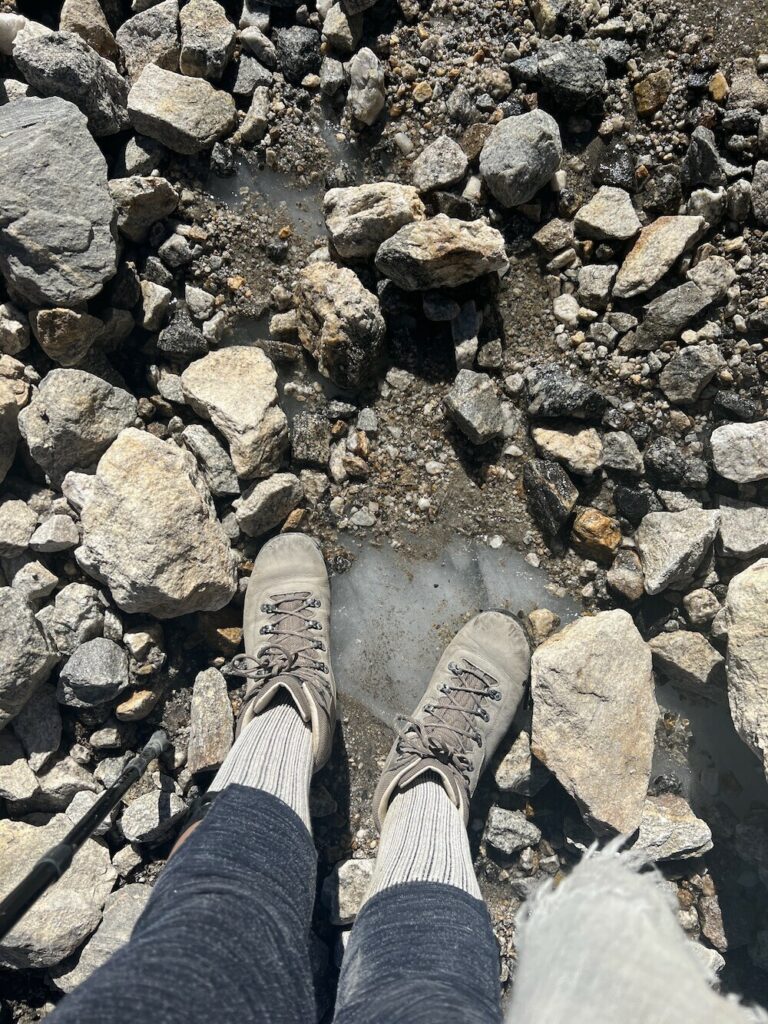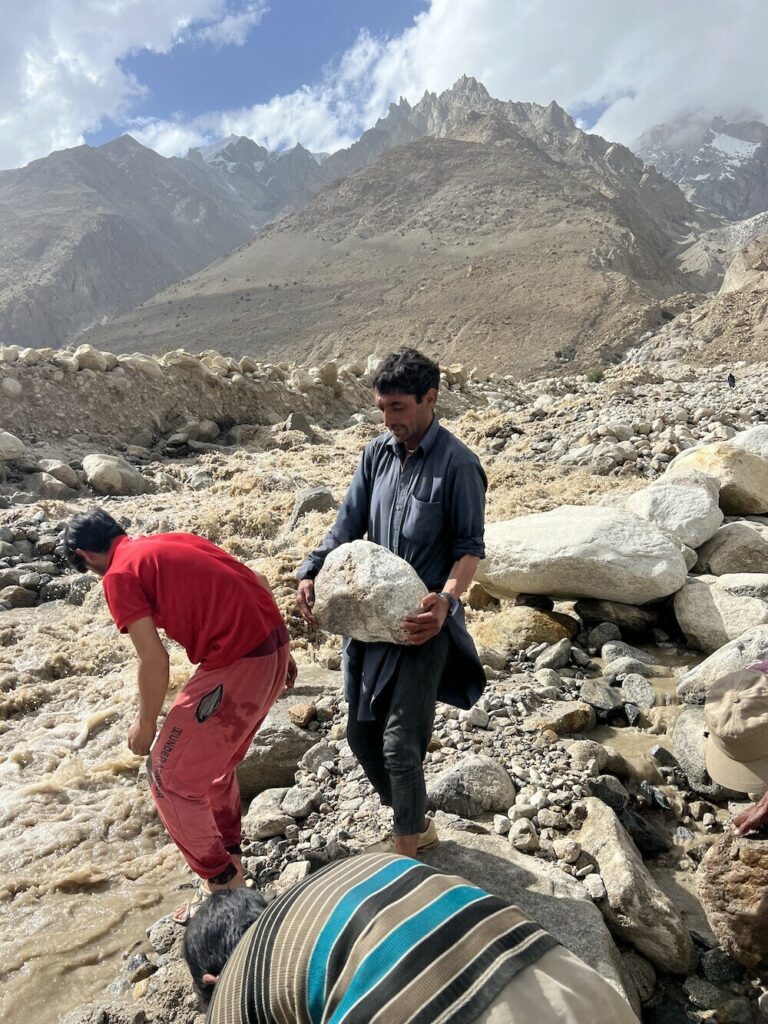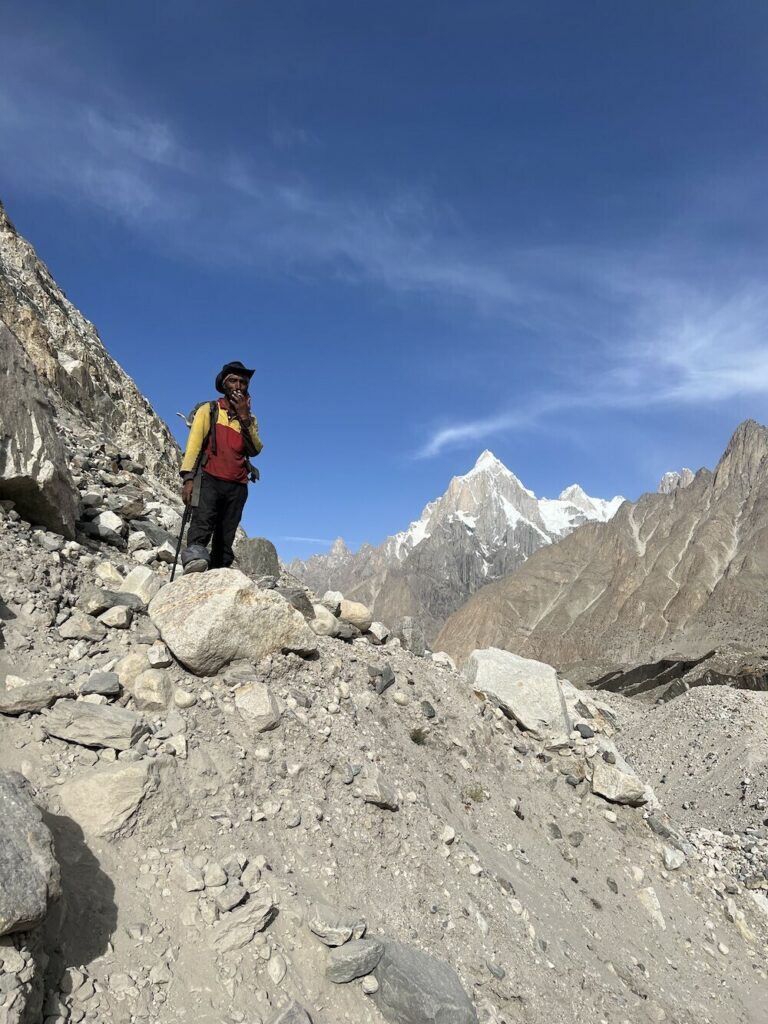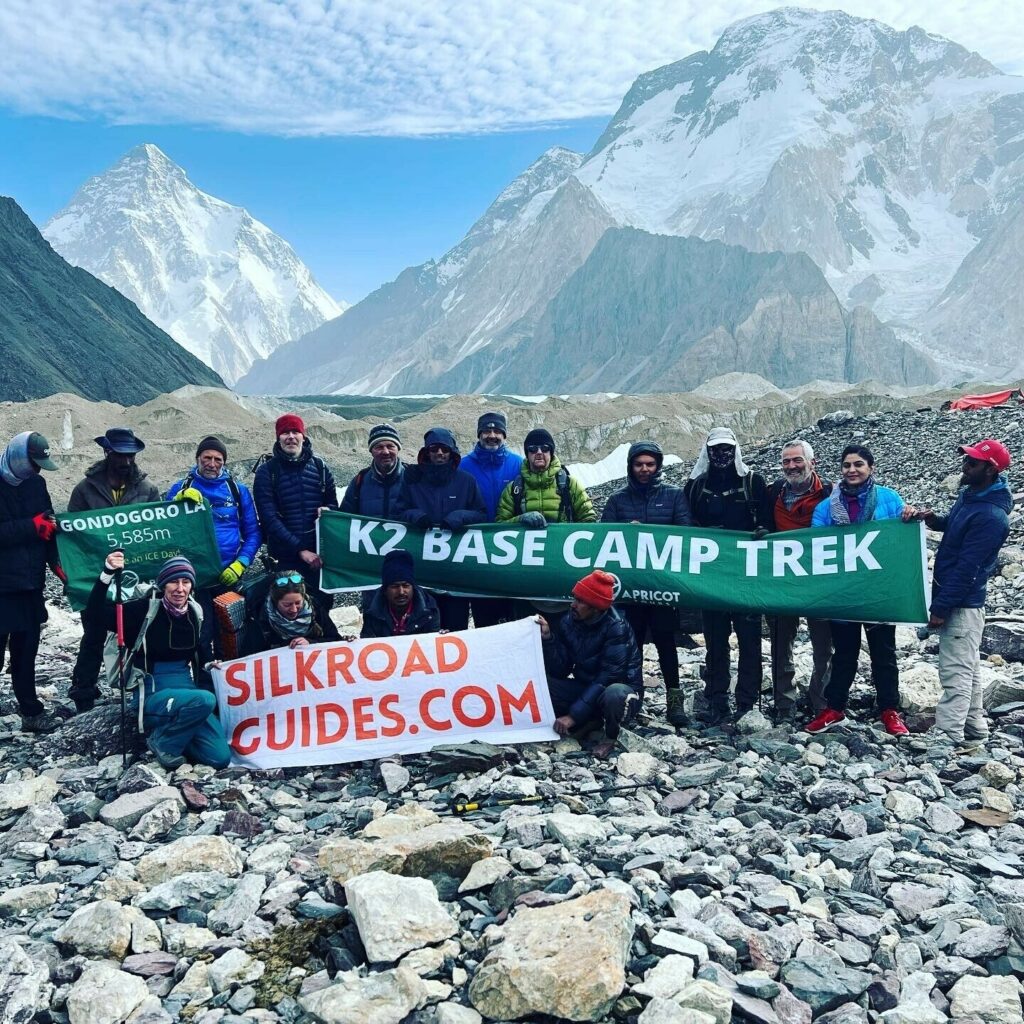27 Jun In pursuit of K2: My journey towards the throne of the mountains
Everything they tell you about the journey being more important is untrue. It is all about crossing that finish line.
Aisha Sarwari Published August 11, 2022 Listen to article
The first thing that strikes you as other-worldly is the silence.
Then there are the occasional rumbles and the splash of baby-blue glaciers rushing into charging aqua blue rivers. The lakes are every shade of green and neon blue. They shouldn’t be there; the mountain glaciers are melting too fast, because we consume too much.
You see a smoke cloud on the north-east of a mountain. It is there one minute, so you squint your eyes, but gone the next. An avalanche.
You learn to read trails. You learn how to read contour lines. You learn to not rely on your eyes. You know pebbles can kill you. You learn to respect shrubs and rocks and shadows even. You learn kings and dollar rates are not going to save you. You learn to read the weather. You learn to observe without your tongue wagging.
The human mind against the mountains
I’m too tired to sit, so I’m lying on the floor of the Baltoro Glacier. This is very far away from my home in Islamabad where perhaps at the end of the workday, I’d have been resting on my carpet like a starfish trying to tune into the next episode of my Netflix binge — anything to forget the avalanches and glacial melts of my inner mess. The Baltoro Glacier – we walked on it, drank from it and slept on it for weeks. — All photos by author
The other thing about the mountains in the north of Pakistan’s Karakoram ranges is the sheer scale.
Why, for instance, do I have to wake up at 5:30am and walk till dusk up the mountains, but the Mitri peak remains in front of me day after day? Why is it taking so long for these gargantuan walls to pass by?
Unlike my 9-5 life, this trek is stoic. I wake with the sun and sleep with the sun. No phone alarms necessary.
The air and earth accompany me in my pursuit of going to see the K2, the second highest peak after the Everest. We are all really doing the same thing here — trying not to disembark from the vehicle of our bodies en route to Concordia, the K2 base camp. Sometimes, I feel my body underneath me, and I haven’t felt one with it in decades. It was always a foe, and now it sort of wants me to tame it.
In my tour group — the dozen of us — a few are not doing too well. Amoebic dysentery, nausea bouts, bile vomit, altitude sickness, confusion, and the blues. Some of us are wondering why we even came. Some of us need human connection, others are just okay to curl under a rock and weep. This is hard work — this reconstruction of our souls and the broken backbones that furnish them.
I’m here, of course, to forget who I am.
Carrying me on me is perhaps the largest burdens of all. My ego and my identity are in a tussle and I just want to find out what the deal is at a molecular level.
My uterus fails fast. My cycle is amuck.
Then it is the discombobulating migraines. I am seeing triple and there is a rainbow aura around the mountains. One that isn’t recorded before by independent observers.

When fatigue sets in
I walk into the tent on day four after a 12-hour trek in the absolute inferno of heat and I don’t see a thing with my left eye. With my right, I can make out my tent mate’s outline. I am blind. Bravo.
I tie a blindfold with my dupatta and put my water bottle behind my neck so I don’t get a heat stroke and lie gently on my back. The edges of my blind eyes are tearing up. I exhale through the mouth slowly. Colour everywhere, life forms bursting forth as defiantly as the mountains from lavender to swamp moss
Breathing is hard. Someone took 70 per cent of the air and replaced it with non-air. Packing my sleeping bag is as laborious as running a half marathon.
Outside my inner darkness, I’ve reached only one-fifth of the way to where I want to go — the Paijju peak. It’s called Paijju or salt because of the barrenness. I have an affinity to the mountain.
I don’t look up, mostly just at my hiking boots that my husband got me to demonstrate support. I feel the boots are lived in like an old sweater, but when I do look up from them, I see the mountains that make me lose balance. I trip and fall each time I look up. Yet these aren’t even the big league mountains. The locals don’t even bother to name them — like the middle child — and I remember why I am here.
I am here because the geography of my inner terrain has structures that are like dissidents. The mountains are all about refusal. Refusal to wear and tear. Refusal to conform. Refusal to be common. Refusal to be broken down. Refusal to belong. To invite. To conform. To live by a code. There is some kinship that makes me seek them to witness me.
No one else allows for so much room to be me. Elsewhere, there is a lot going on for my smallness. Back in the land of busybody humans and machines, there is no space to be too much.
Here inside the tent, nursing my blindness, probably a brain clot of some sort, I am so much freer to breathe the non-air and so much more permitted to let the light in. This is home.

The five needs … and a sixth
Days go on.
I’m officially a trekker now — 15 days of one blistered foot after another.
In the hierarchy of things, trekkers are 12 notches below mountaineers. The mountaineers are at the top because they need speed, agility and mental strength in addition to all the other stuff pro-athletes need. And they need a quantum of crazy.
I’m a Pakistani middle-aged woman, at the brink of all ailments, but I am alive at a time when Samina Baig will be soon summiting the K2. I count that as a blessing. This is up there with the invention of the Covid-19 vaccine.
Another Pakistani woman, permitting me to be someone other than what they say I am. A woman in Askole village letting her daughter peekaboo
I see a black bull, glorious and dare I say, unconcerned about its own BBQ fate walking up ahead of us to be feasted upon if Samina Baig summits and comes down, all limbs intact. There will be a carnivorous party.

She is as stupendous as these mountains — refusal is her motto.
The blindness was only temporary. I pour an oral rehydration salt sachet in my water bottle and sip, slowly opening my eyes and peering to see if I will ever get to see my daughters’ faces again — my older one has porcelain skin and the younger one’s eyelashes are a flower arrangement. I can, I can see them again.
I get over such fears and walk out of the tent. I need to eat.
The mountains have the innate ability to allow yourself to not be taken seriously. You are just carbon molecules seeking to join other carbon molecules. You are on your way to becoming landscape, no matter how important your ego or identity. So you may as well tend to your next five needs — food, water, shelter, excretion, sleep. There is a sixth need: friendship.
The people I am with form a bond. Trauma helps. Someone needs a Ventolin puffer. Someone needs a shoulder rub. Someone needs a sleeping pill. Others play Uno mercilessly with the cooks and guides. We basically fit into each other like enzymes.
There are also those that we would rather not fit into. I’m here to escape oppression of all kinds, but I’m still seeing civilisation’s stratification show up here at almost 16,000 feet — bad manners that impose themselves at the hierarchy of oppressions — white men, white women, white men from shit-hole countries, white women from shit-hole countries, brown men from shit-hole countries, brown women and so on.
I’m such a brown woman and I’m noting that someone is taking up more of the mountain non-air based on a sliding scale. I note that a porter, close to me in arbitrary status, has shattered his shin in a glacial river crossing and a kind geologist on our group has healed him by what can only be described as parental care. What if there was no kind, wise geologist to give this Shakoor Bhai with his cowboy hat and his DHL shirt the medical care he needed?
The same geologist followed me around and plastered my feet to help with blisters. I wouldn’t walk if he didn’t do that.
I note that some people have no hierarchy and operate with the blindfold I had on — everyone gets care and kindness.

I do what is the next right thing to do when survival is important — I ignore the self-important dweebs and smile internally at the kindness that I receive, that others receive. Everyone is saving everyone’s life. The savage mountain is so indifferent to human issues — it busies itself with the ferociousness of its own defiance. Wild flowers everywhere.
I see signs, but almost all of them are unintentional — the Nike tick, the peace sign, the trishul. I read scripture, I read birds, I see wings and cherubic kids and I see Thor’s hammer on these mountains. I see my daughters. Maybe I did listen to too much sufi music on the way, but I saw and moved on.
The mountains are finally passing by faster than one mountain a day. Maybe we are walking faster.
The bag pack I was holding had to be handed over to the tail guide, Aslam — the guide responsible for making sure no one is left behind. For the duration of the trip, I was that person. Plodding along. Crying. Plodding. Sometimes I would have a good lung hour and I would walk fast, which meant I was walking normally and not at the pace of one step per exhale. On those good lung moments, I did deliriously joyous things like open my arms wide and fan around like a paper airplane.
I would soon oscillate into a hiding under a cool rock and say with my snot running down my face: Leave me alone here to die.
The tail guide, evidently aware of such city-girl drama, would use the opportunity to smoke a Marlboro, and at his last puff, I would have gotten the rest I needed to be able to walk again.
I realise almost anything can be endured with rest.
Like all women on the trek alone, I am asked which man I belonged to and where was he and why would my man send me off alone on this extreme trek. Another episode of crying would follow, and another recovery. Almost as soon as they are felt, big emotions dissipate.
The half-way point
Now I am at the halfway point of the trek to Concordia — the throne of the mountain gods.
It looks like I could actually do this. I am not the last to pack. I am not forgetting to fill my water bottle at night, and I am actually having more paper airplane moments, except that a quiet dignity is taking over now. Hard things were done. I am becoming more like our kind geologist on the trek. Fading youth is frightening me less. Porters, horsemen and other local guides and villagers lifting stones to build a makeshift bridge to get us across rivers where sporadic monsoons had broken trekking paths
Wonder is replacing those five needs, and intensity is being replaced by a small quiet unassuming calm.

There is more room for asking questions. Why are there so many confetti colours on the glacial rocks? Why is this rock purple with symmetrical white acid lines? Why is this mountain of glacial ice having its own refusal moment, towering while everything else is flat? Some answers even our kind observant geologist didn’t have. He would take his notebook out and scribble like the Oracle he is. Look back at the snow mountain, and back at his notes. Shake his head. He left it unanswered.
I ask the tail guide Aslam: how come this snow ice mountain isn’t like the Baltoro Glacier — endless kilometres of the largest reserve of the world’s water? Why isn’t this white snow mountain merging into the terrain?
Tail guide smiles his boyish smile and says: The elders have a fable.
Ok? I say.
Translate this new development for kind geologist from Urdu to English.
Aslam explains: The elders say the ice and snow that refuses to merge with rock, silt or debris is the feminine.
I translate.
Oh ya? says kind geologist in his Aussie accent.
And the other pepper colour one? I ask Aslam
The structures that mix with impurities are the masculine.
We raise our eyebrows. Look back at the feminine and the masculine pedestals like salt and pepper shakers.
Makes sense, I say, as if my validation matters — the purity is the feminine and that’s why it withholds breakdown.
Tail guide Aslam gives me the look as if to say: Genius.
Kind geologist makes more scribbles. I look at the structures.
You have to be pure to withstand breakdown — you have to protect your feminine energy. The yin and yang.
The more we talk about fables and rocks, the more I acclimatise to the fast-raising altitude. At some point, however, we have to walk.
Around the corner
There are so many river crossings of glacial cold water that make my legs freeze. Not metaphorically. Literally. You could use my legs for an ice pack at a house party. There are so many slippery slopes. So many hands are held so I can jump the glacial crevices. So many talks to help my red blood cells improve oxygen delivery.
Askole, Jhola, Paiju, Khoburtse, Urdukus, Goro 1 and Goro 2. The journey is now the destination. I got the annoying cliché — it was indeed the journey. I am unconcerned about seeing K2. My heart, shallow and muffled, is louder than it has ever been. I am alive because there is nothing else to take my attention away from my heartbeat, my breath, my gut, my sleep, my thoughts. Shakoor Bhai, who is famous on TikTok for flying punches at unprincipled people, stands here with a shin fracture taking a smoke break
The blindness was temporary, but I also get sick as a dog rather permanently. Asthma, food not settling, and head not stopping the throb throb. It is too much. Stoic or not, rising with the sun or not, my Internet-addicted Dominos-nourished body is giving way.
I have seen so much donkey poo, and though I am grateful it led the way on lost terrain, I am getting sick from the contamination around the camps. I am pill popping, but I am told camp is only two hours away right after the Pakistan Army base camp, but it isn’t.
This, I feel, is not ok.

Nothing could prepare me for the shock of that deception of not seeing camp after the army camp. Emotional mugging is what it is. I have a right to know how far the next camp is.
I sit down defiant, a polluted masculine snow mountain merging and melting away.
But you said it would be around the corner and it’s not, I say to the lead guide.
The tail guide Aslam and the front guide Iqbal Bhai swap. I am guessing Aslam has had enough of me.
Lead guide Iqbal sits like a gargoyle on the edge of the rock atop a cliff. Lights his cigarette and waits for my emotions to subside. It is around the corner, he insists.
I look up with my parched sandy mouth as if to say, really?
For me, he explains, it is around the corner.
And for me? I ask horse-voiced.
For you, I can’t say, he says, puffing in the direction of K2.
I need to know. Everything hurts.
I give him multiple choice. A. 4-5 hours. B. 3-4 hours. C. under two hours.
He stands up and comes over to me. Hands me an empty coke bottle with piss-coloured water in it.
I’m not drinking that, I scoff.
It’s the exact same water you’ve been drinking, he says.
Oh, I say, looking at my black thermos.
I take a sip from his silt water.
I say to Iqbal Bhai: choose A, B or C?
He says it’s hard to tell with someone like you.
I nod: Fine. When in Karakoram, time is not an entity.
I push my body from the ground up vertically and walked without an answer to either of my 1 in 3 certainties.
I walk for another four hours. The sun is heading back home.
Then it happens.
The metaphor happens.
I first see Broad Peak right in front of me. Then Gasherbrum to its right. On the left of my ear, after Muztagh Tower, I see K2’s side arm. I see it waving at me, almost.
This is not a paper plane moment.
I cannot breathe, this is a moment of humility.
Everything they tell you about the journey being more important is untrue. All of it is untrue. It is all about crossing that finish line.
It’s a paradigm shift, duh.
I understand why the mountaineers are better than the trekkers and the trekkers better than the day trekkers who don’t camp under the stars. I understand why purity is better than impurity. Why being unmixed with debris is better than giving into your terrain.
K2 is a feminine structure — a goddess.
The world belongs to the Pakistani woman who is going to summit K2 on the day I merely reached its base camp, Concordia. Samina Baig was probably told, like I was, that a good woman knows how to scrub mugs and plates very clean. Samina Baig is pure as the snow mountains even the world’s best geologists cannot reverse engineer. She refused to pollute what nature gave her.

Instead of seeing K2 as I walked toward it, I saw Samina Baig. K2 wasn’t the only marvel at the basecamp. Rocks of every colour, camps of every neon colour and peaks that had their own personalities dazzled all the same All the tour group posing when we finally made it to Concordia/ the base camp. K2, the middle mountain in the background.
It was so hard to get here. So hard. Yet, for her, the savage mountain was inviting like a mother’s womb.

How is this not magic?
Refusal. Is. Where. Magic. Begins.
Refusal allows you to tap into what’s closest to your instincts.
Nothing wrong with washing mugs but something very inspiring about summiting the hardest, most dangerous mountain ever.
Anyone will tell you gender in Pakistan is impermeably fortified with salt rock walls, whose power protects women from their ambitions as if everything would go bankrupt if a woman chose to live life on her own terms, define her own boundaries of the permissible and the unable.
We are told we hold honour in one hand and shame in another. We are never permitted to open our fists and let those two socially constructed mechanisms go.
I saw Samina Baig in K2
, clear as day. Mountains can be defiant but showing up to honour them is the biggest surrender I had ever experienced.


No Comments